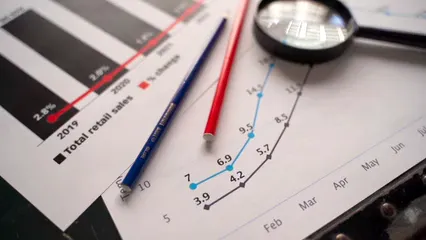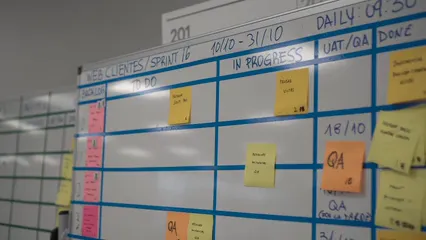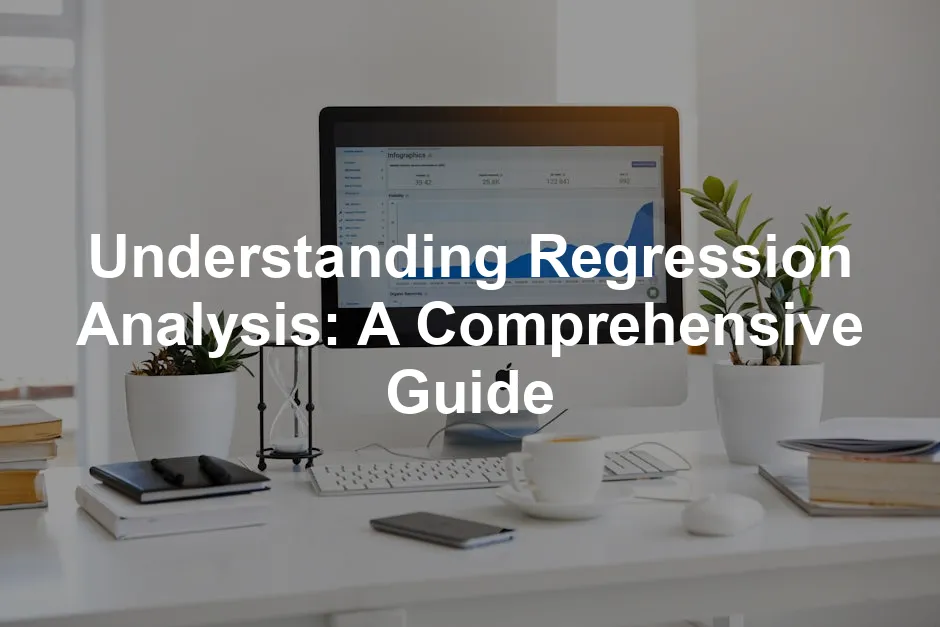Introduction
Regression analysis is a vital statistical method. It helps us understand relationships between variables. Businesses use it for predictions in finance, marketing, and healthcare. This method aids in data analysis by revealing insights that inform decision-making.

Data analysis is crucial for understanding trends and making informed decisions. Tips for effective data analysis in economics and statistics can greatly assist in this process.
If you’re looking to deepen your understanding of statistics, consider picking up “The Art of Statistics: Learning from Data” by David Spiegelhalter. It’s an engaging guide that will help you appreciate the beauty of data analysis while making it less intimidating.
Summary and Overview
Regression analysis quantifies the connection between a dependent variable and one or more independent variables. Its roots date back to the early 19th century, with the method of least squares by Legendre and Gauss. The term “regression” was coined by Francis Galton to describe biological phenomena.
The key components of regression analysis include defining relationships and predicting outcomes. It’s essential for data-driven decision-making, allowing businesses and researchers to understand how changes in one variable affect another. This method finds applications in various fields, from predicting sales based on marketing efforts to analyzing health outcomes influenced by treatment variables.
Understanding regression analysis empowers individuals to make informed decisions based on statistical evidence. It transforms raw data into actionable insights, making it a cornerstone of effective analysis in today’s data-centric world.

To get started with practical applications, you might want to check out “Naked Statistics: Stripping the Dread from the Data” by Charles Wheelan. It’s a witty and accessible read that can make anyone excited about statistics.
What is Regression Analysis?
Definition and Purpose
Regression analysis is a statistical technique used to understand relationships between variables. It helps identify how changes in one or more independent variables impact a dependent variable. The dependent variable is the outcome we want to predict or explain, while independent variables are the factors that influence this outcome.
The primary purposes of regression analysis include prediction, explanation, and relationship modeling. It allows researchers and businesses to forecast future outcomes based on historical data. For example, a company might use regression to predict sales based on advertising spend. Additionally, it helps explain the strength and nature of relationships among variables. By quantifying these relationships, it provides valuable insights for informed decision-making.

If you’re keen on enhancing your programming skills for data analysis, check out “R Programming for Data Science” by Roger D. Peng. This book offers practical insights that can be applied directly to your regression analysis projects.
Types of Regression
Simple Linear Regression
Simple linear regression involves one independent variable predicting a dependent variable. The key formula is Y = a + bX, where Y is the dependent variable, X is the independent variable, a is the y-intercept, and b is the slope. For instance, a business could use this model to predict monthly sales based on the amount spent on advertising.

Multiple Linear Regression
Multiple linear regression extends simple regression by using two or more independent variables. The formula is Y = a + b1X1 + b2X2 + … + bnXn. This method is advantageous for analyzing complex datasets. For example, it can predict house prices based on various features like location, size, and number of bedrooms.
Other Types of Regression
Regression analysis includes various techniques to suit different data types and relationships. Logistic regression is used for binary outcomes, such as predicting whether a customer will buy a product or not. Polynomial regression allows for non-linear relationships by fitting a polynomial equation to the data. Nonlinear regression models complex relationships that cannot be accurately captured by straight lines. Each type serves unique scenarios, thus enhancing the analytical capabilities of researchers and analysts.
Key Components of Regression Analysis
Data Collection
Data quality significantly influences regression analysis outcomes. High-quality data ensures accurate insights. Start by gathering relevant data types, including numerical, categorical, and ordinal data. For effective analysis, consider the sample size. A larger sample size enhances reliability, allowing for generalization to a broader population. Sources of data can vary. Surveys provide firsthand insights, while databases offer historical data. Combining multiple sources enriches the dataset and strengthens analysis. Always remember, the foundation of any regression model lies in solid data collection practices.

Effective data collection is essential for reliable analysis. Check out the best practices for IEP data collection sheets to enhance your data gathering methods.
For those interested in a comprehensive overview of statistical learning, “An Introduction to Statistical Learning: with Applications in R” by Gareth James is an excellent resource to enhance your skills.
Model Specification
Model specification is crucial in regression analysis. It involves selecting the right independent variables to include in your model. Begin by identifying variables that logically relate to the dependent variable. Look for those that have a theoretical basis or prior research supporting their inclusion. It’s essential to avoid multicollinearity, where independent variables are highly correlated. This can distort results and complicate interpretations. To check for multicollinearity, analyze correlation matrices or variance inflation factors (VIF). Properly specifying your model sets the stage for accurate predictions and reliable conclusions.
Assumptions of Regression Analysis
For valid regression analysis, several assumptions must be satisfied. First, linearity is vital; the relationship between independent and dependent variables must be linear. Next, ensure the independence of residuals. This means that the residuals (errors) should not show patterns when plotted. Homoscedasticity is another key assumption, requiring that the variance of residuals remains constant across all levels of the independent variables. Lastly, errors should follow a normal distribution. This can be assessed through histograms or Q-Q plots. Meeting these assumptions is essential for drawing valid insights from your analysis. Failure to do so may lead to misleading results.

If you’re curious about how to apply statistical concepts in real-world scenarios, “Applied Regression Analysis and Generalized Linear Models” by John Fox provides a thorough understanding of these methods.
Performing Regression Analysis
Step-by-Step Guide
Conducting regression analysis can feel overwhelming, but breaking it down into manageable steps helps simplify the process. Here’s how to approach it:
- Data Collection and Preparation: Start by gathering relevant data. Ensure your dataset is clean and complete. This may involve handling missing values or outliers. Data preparation is crucial for accurate results.
- Model Selection: Choose the right regression model based on your data and research question. For instance, if you’re analyzing one independent variable, simple linear regression fits well. For multiple factors, consider multiple linear regression.
- Running the Analysis Using Software: Utilize software tools like R, SPSS, or Excel to perform your regression analysis. Each tool has features that simplify the calculations and visualizations needed. Familiarize yourself with these tools to make the most of their capabilities.
- Interpreting the Output: After running the analysis, focus on understanding the output. Look at coefficients, R-squared values, and p-values. These metrics tell you about the strength and significance of relationships in your data.

For a deeper dive into R programming, you might also want to explore “R for Data Science” by Hadley Wickham. It’s a great resource for anyone looking to harness the power of data in their analysis.
Example Case Study
Imagine a marketing team at a retail company wanting to predict sales based on their advertising spend. They collected data over six months, noting weekly sales figures and corresponding advertising costs.
- Data Collection: They gathered sales and marketing spend data from internal reports.
- Model Selection: The team chose multiple linear regression since they wanted to analyze how different marketing channels impacted sales.
- Running the Analysis: Using Excel, they input their data and applied the regression tool, yielding coefficients for each marketing channel.
- Results Obtained: The analysis revealed that every dollar spent on social media ads increased sales by $3, while email marketing had a $1.50 return. This insight guided their future budget allocations, emphasizing effective channels.

This case illustrates how regression analysis can drive strategic decisions in business.
Evaluating Regression Models
Goodness of Fit
Assessing the performance of regression models is crucial for understanding how well they explain the data. Two key metrics are R-squared and Adjusted R-squared.
R-squared measures the proportion of variance in the dependent variable that the model explains. A value closer to 1 indicates a strong fit, while a value near 0 suggests a poor fit. However, relying solely on R-squared can be misleading, especially in multiple regression scenarios.
Adjusted R-squared adjusts for the number of predictors in the model. It provides a more accurate measure of model performance. If you add a variable that doesn’t improve the model, Adjusted R-squared will decrease, signaling that the model may be overfitting. This metric helps ensure that only relevant variables contribute to the model’s explanatory power.
Together, these metrics allow you to evaluate how well your regression model captures the underlying data patterns. Understanding these values is essential for refining your analysis and making informed decisions based on your findings.

Statistical Significance
Understanding statistical significance is essential in regression analysis. It helps us determine how reliable our model parameters are. A crucial element here is the p-value. The p-value indicates the probability that the observed results happened by chance. A low p-value (typically less than 0.05) suggests that we can reject the null hypothesis. This means the independent variable has a significant effect on the dependent variable.
Confidence intervals also play a vital role in this process. They provide a range of values within which we expect the true parameter to lie. A narrow confidence interval indicates a precise estimate, while a wider one suggests uncertainty. When making decisions, consider both the p-values and confidence intervals. Together, they offer a clearer picture of model reliability and help guide data-driven choices.
Applications of Regression Analysis
Business Applications
Regression analysis is a powerful tool for businesses. Companies use it to enhance decision-making across various domains. For instance, in marketing, businesses analyze the effectiveness of campaigns. By examining data, they can determine which strategies yield the highest return on investment.
Sales forecasting is another crucial application. Companies can predict future sales based on historical data and external factors like seasonality. This information helps in inventory management and staffing decisions.
Financial modeling is also a significant use of regression analysis. Organizations assess risks and returns on investments, enabling strategic planning. By leveraging these insights, businesses can make informed choices that drive growth.

To further enhance your business acumen, consider reading “Statistics for Business: Decision Making and Analysis” by Robert A. Stine. It provides valuable insights into statistical methods tailored for business contexts.
Scientific Applications
In scientific research, regression analysis is invaluable. Researchers use it for hypothesis testing, helping them validate or refute theories. For example, scientists might examine the relationship between drug dosage and patient response. Regression models can reveal whether changes in dosage significantly impact outcomes.
Moreover, regression aids in experimental design. By understanding relationships among variables, researchers can design more effective experiments. This leads to more reliable results and better understanding of complex phenomena. Overall, regression analysis serves as a foundation for rigorous scientific investigation.

If you’re interested in a comprehensive resource on data mining, check out “Data Mining: Concepts and Techniques” by Jiawei Han. It’s a great addition for anyone delving into data science.
Challenges and Limitations
Common Pitfalls
While regression analysis is powerful, it has its pitfalls. One common mistake is overfitting. This occurs when a model is too complex, capturing noise rather than the underlying trend. Conversely, underfitting happens when a model is too simple, failing to capture essential relationships.
Another misconception is confusing correlation with causation. Just because two variables move together doesn’t mean one causes the other. Understanding this distinction is critical. Misinterpreting these relationships can lead to poor decision-making and misguided strategies. For more on this, consider exploring the common pitfalls in parametric statistics assumptions for healthcare data analysis.
Understanding the common pitfalls in regression analysis is crucial for effective data interpretation. Learn more about common pitfalls in parametric statistics assumptions.
Addressing Limitations
To mitigate the challenges of regression analysis, robust statistical practices are essential. Always check your model’s assumptions, such as linearity and independence of errors. This ensures valid results and reliable interpretations.
Validation techniques like cross-validation can help assess model performance. This method divides data into training and testing sets, ensuring the model generalizes well. By applying these techniques, you can strengthen your analysis and make sound conclusions. Implementing these strategies enhances the credibility of your regression analysis results.

Conclusion
In summary, mastering regression analysis is crucial for data-driven decision-making. It provides valuable insights into relationships among variables and helps predict outcomes. By understanding statistical significance, applications, and limitations, you can harness its power effectively. Apply these principles to enhance your analytical capabilities and drive success in your endeavors.

As a bonus for those exploring data visualization, consider checking out “Data Visualization: A Practical Introduction” by Kieran Healy. It’s a great resource to complement your regression analysis skills.
Please let us know what you think about our content by leaving a comment down below!
Thank you for reading till here 🙂
All images from Pexels




